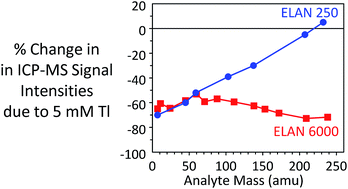Matrix effects using an ICP-MS with a single positive ion lens and grounded stop: analyte mass dependent?†
Abstract
Matrix effects in ICP-MS are generally considered to be more severe for heavy matrix elements and light analyte elements, consistent with space charge repulsion of ions during their travel from the plasma to the mass analyzer. However, the severity of matrix-induced changes in analyte sensitivity as a function of analyte mass may depend on the ion optics design, voltages applied to the ion optics and plasma parameters (robustness). Comprehensive characterization of matrix effects using an instrument with ion optics consisting of a grounded stop, a single positive cylindrical lens and a grounded aperture prior to the RF quadrupole is described. Matrix effects were studied as a function of analyte mass, matrix mass, matrix element concentration, lens voltage, and nebulizer gas flow rate. The effects of high concentrations of a wide mass range of matrix elements (Na, Cu, Y, In, Cs, Tb, Lu, and Tl) on analyte sensitivities with a wide range of masses (7Li+, 11B+, 24Mg+, 45Sc+, 60Ni+, 71Ga+, 75As+, 88Sr+, 111Cd+, 138Ba+, 153Eu+, 172Yb+, 209Bi+, and 238U+) were investigated. Matrix effects for equimolar matrix element concentrations were more severe as the matrix element mass increased. However, the severity of matrix effects depended less on the analyte ion mass than expected. Furthermore, matrix effects on high mass analyte sensitivities were more severe than those reported for first generation ICP-MS instruments.

- This article is part of the themed collection: In memory of Joe Caruso


 Please wait while we load your content...
Please wait while we load your content...